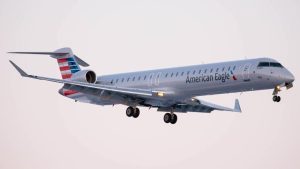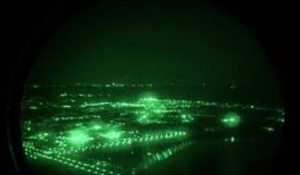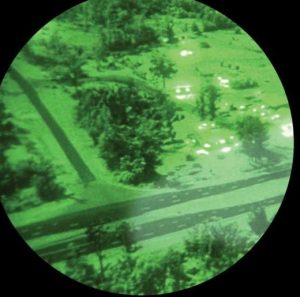The Airline Crash Attorneys at Angelley Hightower have been retained to represent victims of crash of American Eagle 5342 and are closely following the investigation to ensure that our clients receive the most up to date information possible. Hear William Angelley discuss initial information regarding the accident on Voice of America.
Background
On January 29, 2025, at about 8:47 p.m. EST, a Bombardier CRJ 700 aircraft, operated by PSA Airlines and being flown as American Airlines / American Eagle 5342, collided in the air with a U.S. Army U-60 helicopter.

The airplane was on approach for landing at Ronald Reagan Washington National Airport (DCA). The helicopter was on a night training mission. The airplane carried 60 passengers and 4 crew members. The helicopter had 3 crew members on board. All 67 people were killed in the crash. The Flight Data Recorder (FDR) and the Cockpit Voice Recorder (CVR) (both referred to as the Black Box) have been recovered and downloaded by the NTSB. This information provides a preliminary look at the circumstances leading to the crash.
At the time of the crash, AA 5342 was on final for landing on Runway 33. About a half an hour earlier, at 8:15 p.m., AA 5342 began its descent from 37,000 feet. Just prior to the descent, the crew briefed the Troops 5 Arrival, followed by an ILS (Instrument Landing System) approach to Runway 1. ILS systems simply provide pilots with course and glideslope information along the descent path to a particular runway down to about 200 feet. At that point, the runway should be visible to the flight crew. Nonetheless, this data shows that the AA 5342 crew were expecting to land on Runway 1.
At 8:39:10 p.m., Potomac Approach cleared the crew of American Eagle 5342 for the Mount Vernon Visual Runway 1 Approach at DCA. At 8:43:06, the crew switched radio frequencies from Potomac Approach and made initial contact with the DCA tower. The Tower controller immediately asked the crew if it could land on Runway 33 instead of Runway 1. Recall from our airline crash attorneys’ earlier analysis that a few seconds earlier, the DCA Tower asked AA Flight 5307 (another PSA Airlines / American Eagle CRJ 700 arriving at DCA from Montgomery, AL) if it could land on Runway 33. The crew of AA 5307 declined.
The crew of AA 5342, however, agreed to switch from landing on Runway 1 to landing on Runway 33. This change in runways caused American Eagle 5342 to have to divert slightly to the East to line up on Runway 33. At 8:45:27, the crew of AA 5342 disconnected the auto pilot and began their final landing procedures.
At 8:46:01, the DCA Tower then reached out to the helicopter (call sign PAT 25) and informed them that a CRJ aircraft was just South of the Wilson bridge at 1,200 feet and was circling to land on Runway 33. At 8:47:29, the crew of AA 5342 received an automated call out informing them that they were at 500 feet. At 8:47:39, DCA Tower asked PAT 25 (the helicopter) if the CRJ was in sight. One second later, at 8:47:40, the AA 5342 crew received an automated call out that stated, “traffic, traffic.” At 8:47:42, DCA Tower told PAT 25 to pass behind the CRJ.
According to NTSB analysis of the FDR and CVR, at 8:47:58, the AA 5342 crew had some sort of verbal reaction and the nose of the aircraft pitched up slightly. Sounds of impact were heard on the CVR about one second later, and followed by the end of the recording.
The Latest Information from the NTSB
As of February 6, 2025
The NTSB reports that most of the H-60 helicopter has been recovered. The NOAA will be scanning the floor of the Potomac in the coming days searching for additional pieces, including the tail rotor and the right engine.
Although the NTSB has not publicly reported this, Texas Senator Ted Cruz told reporters after a closed briefing, that the Army H-60 helicopter was not flying with its ADS-B (Automatic Dependent Surveillance Broadcast) equipment turned on. This equipment would have allowed the DCA Tower a more accurate look at the helicopter’s altitude and position in the minutes leading up to the crash. Cruz stated that he saw no compelling reason for the ADS-B unit to be turned off.
As of February 4, 2025
The NTSB provided additional information on February 4, though it did not hold a press conference.
First, all 67 passengers have now been recovered.
Second, significant portions of the CRJ wreckage have been removed from the Potomac River, including the right wing, center fuselage, part of the left wing and left fuselage, significant portions of the forward cabin and cockpit, vertical and horizontal stabilizers, tail cone, rudder, elevators, TCAS computer and quick access recorder. The recovered wreckage will be moved to a secure location for a wreckage layout examination. Other reports indicate that the helicopter wreckage will be removed after the CRJ recovery is complete.
Third, the NTSB seemed to back off of earlier reports that the DCA Tower radar showed the helicopter at 200 feet. As of yesterday, the NTSB says that the Air Traffic Control Tower Display is fed by Potomac TRACON (Terminal Radar Approach Control), which is located about 40 miles west/southwest of DCA in Warrenton, Virginia. That set up in itself shows the need for upgrades in the air traffic control system, but nonetheless, yesterday’s NTSB information indicates that the TRACON showed the helicopter flying at 300 feet just before the crash. The NTSB offered no comment or explanation of the earlier 200 feet reports. NTSB reports that the radar information is accurate within 100 feet (plus or minus 50 each way), so the helicopter could have been between 251 and 349 feet. Recent video appears to show the helicopter right at, but perhaps just a little bit lower, than the CRJ, but obviously still at an altitude to result in the mid-air impact.
As of February 3, 2025
The NTSB has conducted three press conferences so far regarding this accident. You can see them all by clicking the links associated with each date. The first two, on January 30 and January 31, respectively, provided mostly preliminary information. The conference held February 1, begins to reveal more detail.
For example, we now know that DCA Tower was communicating out on both VHF and UHF frequencies. This means that aircraft tuned into one or both of the Tower’s frequencies would hear all transmissions. PAT 25 (the helicopter), however, was using only UHF, and American Eagle 5342 was using only VHF. This means that both aircraft could hear the Tower, but they could not hear each other – because they were using different frequencies on different bands.
The NTSB has also confirmed that PAT 25 was on a training mission that would utilize night vision goggles. That does not mean that NVGs were being used at the time of the crash, but simply that at least part of the training exercise involved NVGs. The NTSB is investigating this issue further. As an aside, NVGs in aircraft can be tricky on a standard flight and certainly so in an environment such as near the DCA airport. They can impair depth perception and can be affected by runway, airport and city lights.
The helicopter had a combination CVR and FDR (each contained in the same unit). That has now been recovered by the NTSB and is being analyzed.
Our airline crash attorneys have also learned that the day before this accident, on January 28, 2025, another Priority Air Transport (PAT) flight from the Army – PAT 11 – came in close proximity to a Republic Air flight, which had to reject its landing at DCA because of the contact.
The NTSB has also confirmed that at the time of the accident, there were 5 controllers in the DCA Tower. One was a local controller who was handling helicopter and fixed wing aircraft. This controller also had to handle arrivals, departures, close in air space and the use of the runway. There was also a ground controller who handled all aircraft and vehicles that were not on the runway. There was also a Local Assist Controller who was there to help the Local Controller. There was also an Operations Supervisor, who had direct oversight over the Tower. Lastly, there was an Operational Supervisor In Training. As of now, the NTSB has interviewed the Local Controller, the Ground Controller and the Local Assist Controller. The others will be interviewed in the coming days.
With regard to the altitudes of the aircraft at the time of the accident, the NTSB has some information, but is awaiting data from the helicopter’s FDR. The data from American Eagle 5342’s FDR indicates that it was flying at 325 feet, plus or minus 25 feet, at the time of the crash. That altitude reading is taken from the belly of the CRJ 700. Radar data from the Tower indicates that the helicopter was flying at 200 feet at the time of the accident. That, however, is preliminary information and has yet to be confirmed with the data from the helicopter’s FDR, which is just now being analyzed.
Clearly, the fact that there was a mid air collision indicates, at least preliminarily, that something is off with one or more of those readings. The NTSB, however, is working to analyze the data and figure out if there was some sort of equipment malfunction or data input mistake.
Airline Crash Attorneys Angelley Hightower will continue to closely follow the developments in this crash investigation and will post all new information here as it becomes available.
As of February 14, 2025
The NTSB provided an additional briefing on February 14 that added some new information. The written briefing points can be found here.
The most significant new information released is as follows:
Breaking down the information:
Altimeters
Most aircraft have two kinds of altimeters. One is a radio altimeter and the other, often just called an altimeter, is a barometric altimeter. A radio altimeter system shoots a signal down to the ground or water and receives it back in the aircraft. The resulting time difference tells a flight crew how high they are above the ground or water. In normal flight, crews do not generally use radio altimeter data because it is specific to that particular aircraft in its specific location on the planet. As such, it is not terribly useful for the “big picture.”
An aircraft can be in level flight in the air, but as the ground below rises and falls with the terrain below it, the radio altimeter data will constantly change. Radio altimeter data is useful for landing, as it tells a pilot how high they are above a runway. But it’s only useful in the moments just prior to landing.
The “everyone is on the same page” altimeter data comes from the barometric altimeter. That altimeter tells where a plane is in the sky “above mean sea level.” All aircraft use it, so it essentially records where everyone is, without regard to the ground. A plane at 15,000 feet above the ocean, will be, theoretically, at the same altitude as a plane at 15,000 feet above the Appalachian Mountains.
Barometric altimeters use atmospheric pressure data as a base line, and 29.92 inches of Mercury is the starting point – Standard Day, as it is called. It represents what the atmospheric pressure is on a normal day. From there, depending on the weather where a pilot is, that number will be adjusted up or down. For example, it could be 30.02 or 29.73. Whatever it is, local weather stations track it and usually put it out over an automated information system called ATIS (Automatic Terminal Information Service). About every 100 miles in flight, or when near an airport, pilots (or systems, if they are sophisticated enough) will update ATIS and adjust the setting (29.92 or whatever) on their altimeter.
The NTSB seems to be indicating that there was some kind of issue with the barometric altimeter data on the UH-60 helicopter. We do not yet know what that is, but it could be a faulty system, or a failure of the crew or system to update the pressure setting. We will learn more about that as the investigation continues.
But a faulty barometric altimeter reading in either cockpit could place the two aircraft on a collision course. And again, the last radio altimeter readings showing the aircraft with what appears to be 35 feet of separation depend on what was directly below each aircraft at the time of that last reading. Plus, the CRJ was descending at 448 feet per minute when that recording was made. Thus, the NTSB is closely following up on the barometric altimeter data.
“Pass Behind” Transmission
The stepped-on transmission from ATC telling the helicopter to “pass behind” the CRJ is noteworthy, but not terribly causal in our opinion. Given where the two aircraft were at the time, if the helicopter saw the CRJ on final for landing, no one would really need to tell the crew to avoid it, and no rational helicopter crew would try to avoid by getting in front of it. But, the episode does demonstrate the last minute chaos in the cockpits and perhaps the overly casual address by the Tower.
Night Vision Goggles
The use of NVGs by the Army helicopter could be a significant contributing factor. NVGs basically work by taking small amounts of light, including infrared light, and using that light to create an enhanced image that is visible to the human eye in dark environments.
The key here, however, is the word small. NVGs work best with small amounts of ambient light. If there is too much light outside, the view from the NVGs can contain too much glare to be useful. Below are two images taken through NVGs. The one on the left is taken from an area with more outside light, such as near a city, and the one on the right is taken from an area with less outside light. One can see that in places with small amounts of outside light, the image is much sharper. When there is more light outside, the image is more glared and distorted, and a little overwhelming for the pilot, providing less detail.


The area around DCA is extremely well lit outside, greatly reducing the effectiveness of the NVGs. More information is needed as to whether all the helicopter crew was using NVGs, or just the flying pilot, and what kind of NVGs were being used, etc. before we have a full picture of the impact that NVGs may have had on this accident. But, if the crew or the flying pilot was using NVGs around DCA at the time of the accident, it is a near certainty that visibility was impacted in some manner.
Legal Liability
Once more information is available, a better picture of what happened and why will come into focus. It is too early to tell who is responsible for this accident, but the initial possibilities include the Army, for its operations and perhaps training element, the FAA for the acts or omissions of the Tower, and American Airlines.
Claims against the Army and the FAA, both being part of the Federal Government, will involve the Federal Tort Claims Act, and will begin with the submission of a Form 95 claim. The government then has six months to accept or reject the claim. If rejected, the claim is usually followed by a lawsuit. Suits against the government would have to proceed in Federal Court in an appropriate location. It is likely that all three entities, and maybe others, will be joined in one or more actions by the families.
One thing to note, however, is that it is a violation of federal law (Aviation Disaster Family Assistance Act) for any attorney to contact any family member of one of the victims before the expiration of 45 days following the accident. Often times following such accidents, unscrupulous attorneys and/or folks they hire, will attempt to contact family members directly, or under the guise of trying to provide help or counseling in some fashion.
If you know or are related to a victim of the crash of AA 5342, please note this information and do not communicate with anyone attempting to solicit you. Reputable airline crash attorneys will wait for you to contact them. Take your time and find the right experienced attorney and the right fit for you and your family.